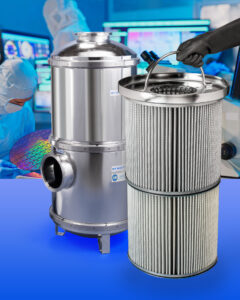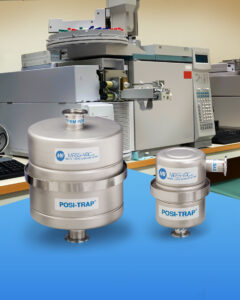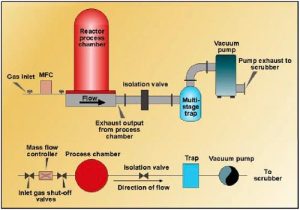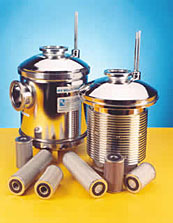
Vacuum Pump Inlet Trap For Heavy Contaminant Vacuum Processes
A high-capacity vacuum pump inlet trap designed to remove high quantities of contaminants from LPCVD, PECVD, MOCVD, HVPE, ALD and similar processes has been introduced
The costs involved in maintaining vacuum processes in a manufacturing facility can often exceed most other maintenance costs. Pump failures, clogged or sticking valves, and clogged exhaust lines are some of the catastrophic failures that cause lost yield, high downtimes, and high labor costs. Routine maintenance can reduce the frequency of catastrophic failures but demands significant downtime and labor. In addition, many vacuum processes cause stress on the downstream effluent treatment facilities, further increasing equipment downtime and maintenance costs. To reduce these costs, many vacuum experts have installed vacuum pump traps in their vacuum systems. Efficient trapping of nongaseous effluent keeps the vacuum system free from residues, reducing or eliminating pump failures and clogged lines.
Traditionally, trapping uses a single particle elimination stage – either a “knock-down” stage, where baffling and gravity eliminate large solid particles from the gas stream, or a water cooling stage, which solidifies and removes high vapor pressure materials. While these methods reduce the periodic maintenance required, they do not eliminate catastrophic pump failures because they leave significant quantities of non-gaseous effluent in the exhaust stream.
This article describes how three- or four-stage trapping systems remove the majority of failure-causing effluent. Trapping systems of this type have been shown to reduce unscheduled downtime by over 70% and scheduled maintenance by over 50% and to increase equipment capacity by 1-2%. The multi-stage approach provides cost savings due to increased throughput (capacity), reduced personnel costs, and reduced service costs. Several examples are described, including deposition, etch, and ion implant systems.
A multi-stage trap includes three or four particle elimination stages. The stages include a knock-down stage and an optional water cooling stage, followed by one or two stages of mechanical and/or chemical filtration.
The first stage in a multi-stage trap is a knock-down stage in which effluent-containing gases form precipitates as they enter a larger volume (Figure 1, Stage 1). In the example shown, a large exterior canister and a concentric interior canister work together to form the knock-down stage. A pressure drop occurs between the vacuum line to the trap and the space between the two canisters, due to the large volume in this knock-down area. When the exhaust gas enters this area, the pressure drop slows down the exhaust gases, causing large particulates to precipitate and collect on the large surface areas in this stage of the trap. Vapors entrained in the exhaust stream may also condense in the knock-down stage.
Figure 1. Multiple trapping stages remove nongaseous effluent, reducing or eliminating vacuum system failures.
For processes with large quantities of entrained vapor, the knock-down stage may not condense enough vapor to prevent unwanted condensation in other areas of the exhaust system. In this case, a multi-stage trap may require a cooling stage (Figure 1, Stage 2).The final stages of the multi-stage trap consist of one or two filtration stages (Figure 1, Stages 3 and 4). Depending on the effluent gases in the process, different types of filters may be appropriate.

A high-capacity vacuum pump inlet trap designed to remove high quantities of contaminants from LPCVD, PECVD, MOCVD, HVPE, ALD and similar processes has been introduced

A line of robust vacuum pump exhaust traps for use with dry scroll pumps to remove carbon soot which can damage recirculation systems has been introduced

Cleaning up an LPCVD Silicon Nitride Deposition System A typical application for a multiple-stage vacuum pump trap is a reactor that deposits silicon nitride (Si3N4)

Throughput Increases in Silicon Dioxide Deposition Systems Another common application for a multiple-stage vacuum pump trap is a CVD (chemical vapor deposition) process to deposit

Multi-Stage Traps Clean Up Vacuum Systems Cleaning up an LPCVD Silicon Nitride Deposition System A typical application for a multiple-stage vacuum pump trap is a

Multi-Stage Traps Clean Up Vacuum By Herbert W. Gatti and Lise C.H. Laurin The costs involved in maintaining vacuum processes in a manufacturing facility can
247 Rangeway Road
PO Box 359
North Billerica, MA 01862-0359
P: 978 667 2393
F: 978 671 0014
Email: sales@massvac.com
© 2024 MassVac Inc.
Webdesign by Turek Design